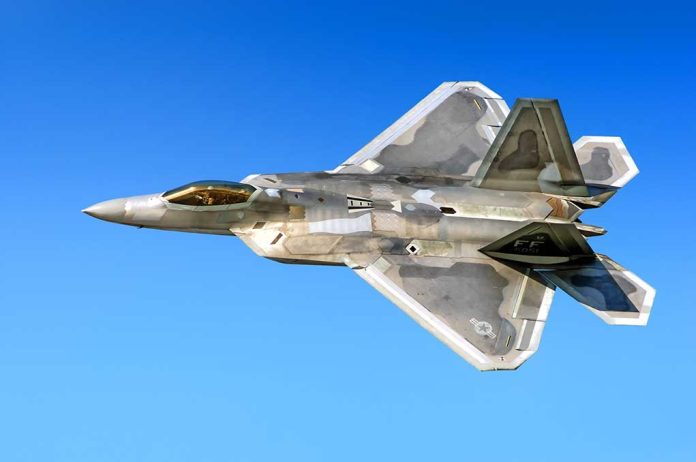
Israeli forces obliterated two Iranian F-14 Tomcat fighter jets in a massive fiery explosion captured by drone footage, marking a dramatic escalation in the four-day conflict that has already claimed 224 Iranian and 24 Israeli lives.
Key Takeaways
- Israel has destroyed two Iranian F-14 Tomcat fighter jets (made famous by the movie “Top Gun”) in a preemptive airstrike near Tehran.
- The IDF has hit over 170 targets and more than 720 military facilities across Iran in less than three days, claiming complete air dominance over Tehran.
- Iran’s missile stockpile is rapidly depleting as Israel targets critical infrastructure, IRGC bases, and propaganda centers.
- Iranian authorities have intensified domestic crackdowns amid growing public unrest, with Iranian Supreme Leader Khamenei reportedly hiding in a fortified bunker.
- President Trump has expressed openness to mediate the conflict while vetoing an Israeli plan to assassinate Iran’s Supreme Leader.
Israel’s Precision Strike Against Iran’s Iconic Fighter Jets
The Israeli Defense Forces released dramatic footage showing the destruction of two Iranian F-14 Tomcat fighter jets at an airbase near Isfahan. These American-made aircraft, which gained worldwide fame in the 1986 Hollywood blockbuster “Top Gun,” were reportedly preparing to intercept Israeli aircraft when they were targeted. According to IDF statements, “These jets were intended to intercept Israeli aircraft,” highlighting Israel’s strategy of neutralizing threats before they materialize.
The F-14s represent a significant piece of Iran’s dwindling military aviation assets. Originally, Iran purchased 79 of these advanced fighters from the United States before the 1979 Islamic Revolution transformed the country from a Western ally into an adversary. The destruction of these jets underscores the challenges Iran faces in maintaining its aging fleet of American military hardware under decades of sanctions that have prevented access to spare parts and technical support.
Israel’s Expanding Air Campaign
Israel’s military operations have expanded dramatically across Iran in recent days, targeting critical infrastructure and propaganda centers. The IDF has reported striking over 170 targets and more than 720 military facilities in less than three days, claiming complete air dominance over Tehran. These operations have included precision strikes against IRGC air bases, missile convoys, and regime buildings in the Iranian capital, demonstrating Israel’s extensive intelligence capabilities and operational reach.
Among the high-profile targets was the residence of Ali Shamkhani, an advisor to Iran’s Supreme Leader, who was reportedly wounded in the attack. The IDF has also successfully assassinated several IRGC intelligence officials, including Mohammad Kazemi, further degrading Iran’s military command structure. A massive fire at the Shahran oil depot and bombing of Iran’s state broadcaster have been attributed to Israeli strikes, aimed at crippling both Iran’s energy infrastructure and propaganda apparatus.
Iranian Regime Under Pressure
As the conflict intensifies, Iran’s ability to respond appears increasingly limited. Reports indicate that the country’s missile stockpile is dwindling rapidly, with top regime officials either dead or in hiding. Supreme Leader Khamenei has reportedly moved to a fortified bunker as Israeli forces demonstrate their ability to strike anywhere within Iranian territory. In response to these vulnerabilities, Iranian authorities have intensified domestic crackdowns, slowing internet speeds, expanding security presence, and arresting civilians suspected of sharing pro-Israel content.
Despite claims by foreign media about a potential assassination plan targeting Khamenei, Israeli officials have firmly denied such reports. “False,” stated Prime Minister Netanyahu, while Israeli National Security Advisor Tzachi Hanegbi called the reports “fake news of the highest order.”
Public unrest within Iran appears to be growing, with reports of anti-regime chants against Khamenei. The Iranian government’s discovery of a workshop allegedly used by Israelis to assemble drones highlights the extensive infiltration of Israel’s intelligence apparatus within Iran. Meanwhile, the regime’s dismissal of IDF evacuation notices for Tehran’s District 3 has placed civilians at increased risk as the conflict continues to escalate.
International Responses and Regional Implications
The United States has publicly denied direct involvement in the conflict while simultaneously increasing its military presence in the region. The USS Nimitz aircraft carrier is heading to the Middle East, accompanied by a substantial aerial deployment, signaling American readiness to protect its interests and allies. President Trump reportedly vetoed an Israeli plan to assassinate Iran’s Supreme Leader Khamenei, demonstrating the complex dynamics of U.S. involvement in the conflict despite Israel’s denial of such a plan.
Meanwhile, Russian President Putin has offered to mediate the crisis, but the European Union has rejected this proposal. China is believed to be supplying Iran with critical weapons, further complicating the international dimensions of the conflict. As Iran continues to launch missiles at Israel with diminishing effectiveness, the regional balance of power appears to be shifting decisively in Israel’s favor, potentially reshaping Middle Eastern geopolitics for years to come.









